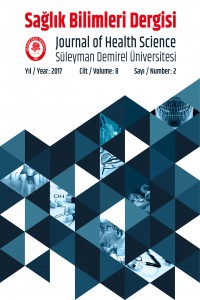Öz
Anahtar Kelimeler
Kaynakça
- 1. Poirier J, Parkinson J. Geriatrie et Psychologie Neuropsychiatrie Du Vieillissement 2013; 11(1): 65–72. 2. Kalia LV, Lang AE. Parkinson’s disease. The Lancet 2015; 386(9996): 896–912. 3. Tsanas A, Little MA, McSharry PE, Ramig LO. Accurate telemonitoring of Parkinson’s disease progression by noninvasive speech tests. IEEE Transactions on Biomedical Engineering 2010; 57(4): 884–893. 4. Tsanas A, Little MA, McSharry PE, Ramig LO. Enhanced Classical Dysphonia measures and sparse Regression for Tele Monitoring of Parkinson’s disease Progression 2010; 594–597. 5. Goetz CG, Stebbins GT, Wolff D, DeLeeuw W, Bronte- Stewart H, Elble R, Hallett M, Nutt J, Ramig L, Sanger T, Wu AD, Kraus PH, Blasucci LM, Shamim EA, Sethi KD, Spielman J, Kubota K, Grove AS, Dishman E, Taylor CB. Testing objective measures of motor impairment in early Parkinson’s disease: Feasibility study of an at-home testing device Movement Disorder 2009; 24(4): 551-556. 6. Little MA, McSharry PE, Hunter EJ, Spielman J, Ramig LO. Suitability of dysphonia meas-urements for telemonitoring of Parkinson’s disease. IEEE Trans. Biomed. Eng. 2009; 56(4): 1015-1022. 7. Amato F, López A, Peña-Méndez EM, Vaňhara P, Hampl A, Havel J. Artificial neural networks in medical diagnosis. Journal of Applied Biomedicine 2013; 11(2): 47-58 8. Hofmann M, Klinkenberg R. RapidMiner: Data MiningUse Cases and Business Analytics Applications Chapman & Hall / CRC Data Mining and Knowledge Discovery Series, CRC Press, 2013 9. Jankovic, J. Parkinson’s disease: Clinical Features and Diagnosis. J Neurol Neurosurg Psychiatry 2008; 79(4): 368- 76.
Vocal Cord Measures Based Artificial Neural Network Approach for Prediction of Parkinson’ s Disease Status
Öz
Objective: Parkinson’s disease is a chronic
neurodegenerative impairment which causes movement
impairment. Dopaminergic deficiency resulted from the loss
of dopaminergic neurons in the substantia nigracauses the
disease. UPDRS (Unified Park-inson’s disease rating scale)
is an important scale for evaluation of clinical severity of
Parkinson’s disease. Recent computational studies using in
silico prediction methods show promising results in terms
of their potential diagnostic relevance. This study aims to
evaluate the diagnostic potential of in silico methods using
vocal cord vibrations and the UPDR scale of Parkinson’s
Disease for obtaining more precise diagnosis model.
Material-Method: In this study an in silico prediction model
using telemonitoring measures, clinical motor and total
UPDRS for diagnosis of Parkinson’s disease was developed
by using regression analysis with neural network model. In
addition, we investigated the importance of different attributes
in our regression algorithm provided from telemonitoring and
UPDRS for evaluation of their predictive relevance.
Results: The correlation between predicted motor UPDRS
score and clinical motor UPDRS score was found as 97%.
Exclusion of Jitter values did not directly affect the predictive
power of the model.
Conclusions: Clinical UPDRS scoring proved its importance
to achieve to generate more predictive models.
Anahtar Kelimeler
Parkinson’s Disease Artificial Neural Network Regression Analysis
Kaynakça
- 1. Poirier J, Parkinson J. Geriatrie et Psychologie Neuropsychiatrie Du Vieillissement 2013; 11(1): 65–72. 2. Kalia LV, Lang AE. Parkinson’s disease. The Lancet 2015; 386(9996): 896–912. 3. Tsanas A, Little MA, McSharry PE, Ramig LO. Accurate telemonitoring of Parkinson’s disease progression by noninvasive speech tests. IEEE Transactions on Biomedical Engineering 2010; 57(4): 884–893. 4. Tsanas A, Little MA, McSharry PE, Ramig LO. Enhanced Classical Dysphonia measures and sparse Regression for Tele Monitoring of Parkinson’s disease Progression 2010; 594–597. 5. Goetz CG, Stebbins GT, Wolff D, DeLeeuw W, Bronte- Stewart H, Elble R, Hallett M, Nutt J, Ramig L, Sanger T, Wu AD, Kraus PH, Blasucci LM, Shamim EA, Sethi KD, Spielman J, Kubota K, Grove AS, Dishman E, Taylor CB. Testing objective measures of motor impairment in early Parkinson’s disease: Feasibility study of an at-home testing device Movement Disorder 2009; 24(4): 551-556. 6. Little MA, McSharry PE, Hunter EJ, Spielman J, Ramig LO. Suitability of dysphonia meas-urements for telemonitoring of Parkinson’s disease. IEEE Trans. Biomed. Eng. 2009; 56(4): 1015-1022. 7. Amato F, López A, Peña-Méndez EM, Vaňhara P, Hampl A, Havel J. Artificial neural networks in medical diagnosis. Journal of Applied Biomedicine 2013; 11(2): 47-58 8. Hofmann M, Klinkenberg R. RapidMiner: Data MiningUse Cases and Business Analytics Applications Chapman & Hall / CRC Data Mining and Knowledge Discovery Series, CRC Press, 2013 9. Jankovic, J. Parkinson’s disease: Clinical Features and Diagnosis. J Neurol Neurosurg Psychiatry 2008; 79(4): 368- 76.
Ayrıntılar
| Konular | Sağlık Kurumları Yönetimi |
|---|---|
| Bölüm | Araştırma Makaleleri |
| Yazarlar | |
| Yayımlanma Tarihi | 14 Nisan 2017 |
| Gönderilme Tarihi | 14 Nisan 2017 |
| Yayımlandığı Sayı | Yıl 2017 Cilt: 8 Sayı: 2 |


